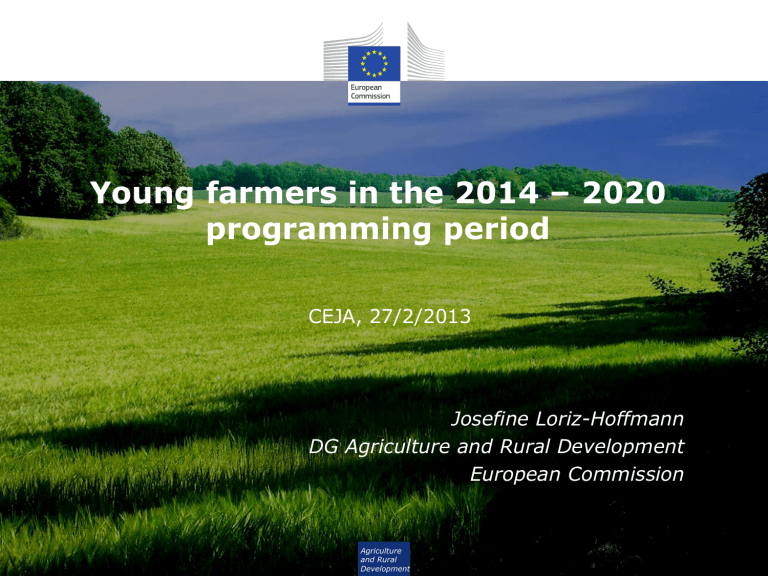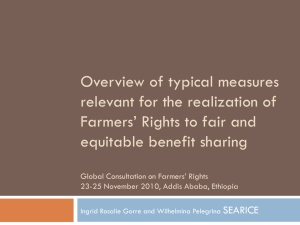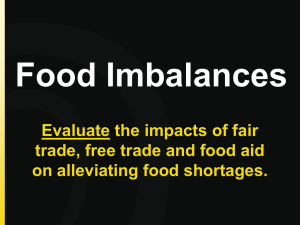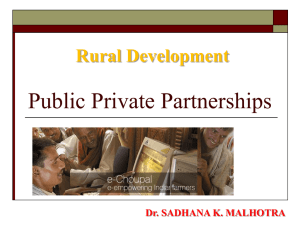111012_CAP2020_Greenteam_EN_final

Young farmers in the 2014 – 2020 programming period
CEJA, 27/2/2013
Josefine Loriz-Hoffmann
DG Agriculture and Rural Development
European Commission
Agriculture and Rural
Development
Where are we with the CAP reform process?
12 October 2011
21 January 2013
Commission legal proposals on the CAP
COMAGRI adopted its mandate
Spring 2013
July 2013
Trialogues
Agreement between legislators
Young farmers
Pillar I and its relation to Pillar II
Support for young farmers in the CAP first pillar
Coupled support
• Wide range of sectors
•
Up to 5% or 10% of DP envelope, to be decided by MS
Natural constraint support
• For areas with natural constraints
• Up to 5% of the DP envelope
Young Farmer Scheme (Council – optional, EP- obligatory)
•
Up to 2% of DP envelope
• < 40 years
• For 5 years
• Commencing activity
• Crop diversification
•
Permanent grassland
• Ecological focus area
‘Green’ Payment
• 30% of the DP envelope
Basic Payment Scheme
•
National or regional flat rate per eligible hectare
•
Regions and criteria to be chosen by MS
•
New entitlements in 2014
• Definition of agricultural activity
•
Definition of active farmer
OR
Small Farmer Scheme
• Simplification of claims and controls
• Lump sum payment to be determined by MS under conditions
• Entrance in 2014
• Up to 10% of the DP envelope
4
Young farmers in pillars I and II
Pillar I
Obligatory/optional component of direct payment
Up to 2% of DP envelope
Less than 40 years old at the time of application
No further requirements
Farmers setting up for the first time or having set up in the past five years
Pillar II
An optional RD measure (business development)
No ringfencing of the budget
Less than 40 years old at the time of application
Occupational skills + business plan
Farmers setting up for the first time
Payment over maximum 5 years, minus the years between having set up and the application
Annual payment (part of DP) – payments calculation in Article 36 of DP draft
Regulation
Flat rate with at least two instalments over maximum 5 years. Last instalment conditioned by fulfilling the business plan
Maximum EUR 70,000
5
Young farmers - definitions
• Pillar I: natural persons who are setting up for the first time an agricultural holding as head of the holding, or who have already set up such a holding during the five years preceding the first submission of an application to the basic payment scheme as referred in Article 73(1) of the Horizontal
Regulation, and who are less than
40 years of age at the moment of submitting the application.
• Pillar II: farmer who is less than 40 years of age at the moment of submitting the application, possesses adequate occupational skills and competence and is setting up for the first time in an agricultural holding as head of the holding.
6
Young farmers
Pillar II
Beyond 2013: an outlook for young farmers
• Young farmers can contribute the most to fostering innovation and
resource-efficiency to achieve the EU2020 objectives.
• Young farmers have access to all support instruments, i.e. those specifically designed for them and those which can be tailored to their specific, local needs.
• Promising approaches – to bundle and combine measures for
young farmers with a strategic and flexible approach in relation to the rural development priorities. Also cooperation and collective approaches are encouraged.
8
Thematic sub-programmes
• Member States may include within their rural development programmes thematic sub-programmes, contributing to the Union priorities for rural development
• Aimed to address specific needs identified, in particular in relation to:
(a) young farmers ;
(b) small farms;
(c) mountain areas;
(d) short supply chains
• An indicative list of measures and types of operations of particular relevance to each thematic sub-programme is set out in the Annex to the rural development Regulation
9
Indicative list of measures and operations of particular relevance to a YF thematic sub-programme
• Business start-up aid for young farmers setting up for the first time in an agricultural holding
• Investments in physical assets
• Knowledge transfer and information actions
• Advisory services, farm management and farm relief services
• Co-operation
• Investments in non-agricultural activities
10
Other targeting tools alongside sub-programmes
• Selection criteria: in some MS priority to farms, e.g.
whose business plan combines the setting up measure with other RD measures (e.g. farm investment)
where the holder is a young woman or young migrant
• Higher aid intensities (up to +20% than standard rates) for YF setting up within the measure for investments in physical assets
11
Article 20: Specific support for YF (1)
• Business start-up aid for young farmers
– Conditional on submission of a business plan whose implementation has to start within 6 months from the date of the decision granting the aid
– YF whose starting size is to be defined by MS, but significantly higher than the upper threshold applied to small farms development
(also supported under art. 20)
Delegated acts to cover:
Conditions under which a legal person may be considered a 'young farmer', including setting of a grace period for the acquisition of occupational skills
Minimum content of the business plan
Criteria to be used by Member States for setting the thresholds applying to young farmers and small farms
12
Article 20: Specific support for YF
• Aid rates:
– Max 70.000 per young farmer
– Amount of support shall also take into account the socioeconomic situation
– Flat rate payment, which may be paid in at least two instalments over a period of maximum 5 years
– Instalments may be degressive
– Payment of the last instalment conditional upon the correct implementation of the business plan
13
Financial instruments
• What is it?
• A possibility for Member States to use EAFRD funding in a different form than grants for supporting viable investment decision, facilitating in this way the access to financing for businesses targeted by the RDPs
• Types of instruments
• Loans, Guarantees, Equity, etc.
• Implementation mode – Decision to be taken by MA
• Value added associated with FIs
• Better access to capital and financial resources
• Efficient use of funds - a pool of funds can be re-used several times and reach more beneficiaries
• Possibility to combine financial instrument with grants
• Leverage effect
• Increasing the sustainability of the business environment – support provided before investment to start
• Higher impact of public (incl. EAFRD) resources
For further information
• The CAP after 2013 http://ec.europa.eu/agriculture/cap-post-2013/index_en.htm
• Commission Communication ‘ The CAP towards 2020 ’ http://ec.europa.eu/agriculture/cap-post-2013/communication/index_en.htm
• EIP http://ec.europa.eu/agriculture/eip/index_en.htmhtm
• Legal proposals http://ec.europa.eu/agriculture/cap-post-2013/legal-proposals/index_en.htm









